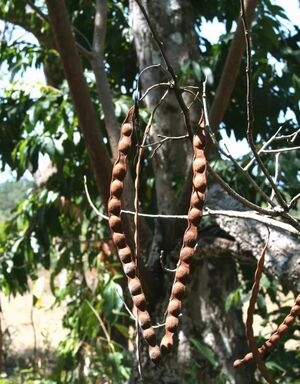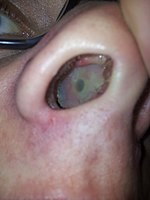Anadenanthera peregrina
| Anadenanthera peregrina | |
|---|---|
|
Anadenanthera peregrina tree with seeds showing, also called yopo |
|
| Taxonomical nomenclature | |
| Kingdom | Plantae |
| Unranked | Angiosperms |
| Unranked | Eudicots |
| Unranked | Rosids |
| Order | Fabales |
| Family | Fabaceae |
| Genus | Anadenanthera |
| Species | A. peregrina |
| Common nomenclature | |
| Common names | Yopo, Jopo, Cohoba |
| Constituents | |
| Active constituents | 5-MeO-DMT, DMT, Bufotenin[1] |
Anadenanthera peregrina (also known as Yopo, Jopo, or Cohoba) is a perennial tree native to the Caribbean and South America.
The beans of the Anadenanthera pergrina plant have been noted to contain significant quantities of bufotenin alongside lesser amounts of 5-MeO-DMT and DMT, all of which have a long history of use as entheogens. It has been used for ritual and healing purposes for thousands of years.
History and culture
Archaeological evidence shows Anadenanthera beans have been used as hallucinogens for thousands of years. The oldest clear evidence of use comes from smoking pipes made of puma bone (Felis Concolor) found with Anadenanthera beans at Inca Cueva, a site in the northwest of Humahuaca in the Puna border of Jujuy Province, Argentina. The pipes were found to contain the hallucinogen DMT, one of the compounds found in Anadenanthera beans. Radiocarbon testing of the material gave a date of 2130 BC, suggesting that Anadenanthera use as a hallucinogen is over 4,000 years old.[2]
Some tribes use yopo along with Banisteriopsis caapi to increase and prolong the visionary effects.[citation needed]
Snuff trays and tubes similar to those commonly used for yopo were found in the central Peruvian coast dating back to 1200 BC, suggesting that insufflation of Anadenanthera beans is a more recent method of use.[citation needed] Archaeological evidence of insufflation use within the period 500-1000 AD, in northern Chile, has been reported.[3]
Some indigenous peoples of the Orinoco basin in Colombia, Venezuela and possibly in the southern part of the Brazilian Amazon make use of yopo snuff for spiritual healing. Yopo snuff was also widely used in ceremonial contexts in the Caribbean area.[citation needed]
Entheogenic uses
Snuff
Yopo snuff is usually blown into the user's nostrils by another person through bamboo tubes or sometimes snuffed by the user using bird bone tubes. Blowing is more effective as this method allows more powder to enter the nose and is said to be less irritating. In some areas, the unprocessed ground beans are snuffed or smoked producing a much weaker effect with stronger physical symptoms.
Inhaling Yopo can cause considerable pain in nostrils. However, this pain usually subsides within minutes. Physical effects include tingling and numbness throughout the body and an increased heart rate. The hallucinatory effects follow as colors become enhanced and shapes appear to morph. The effects of Yopo intensify quickly but gradually fade and are replaced by nausea and general bodily discomfort.
Oral use
When taken orally by some tribes in South America, small amounts are often combined with alcoholic chichas (maize beer). Moderate doses are reported to be unpleasant, producing nausea and vomiting. The beans were a main ingredient in bilca tauri, an oral purge medicine used to induce ritual vomiting once a month.[4] Large amounts are not usually consumed orally; as many tribes believe oral use is dangerous.
Use with MAOIs
Some South American tribes have been documented to use various bean preparations along with Banisteriopsis caapi, an herb containing MAOIs.[4] Typically Banisteriopsis caapi is chewed in the mouth while the Anadenanthera beans are snuffed or smoked.[4] Occasionally Banisteriopsis caapi is found mixed in with the snuff.[4] Moderate amounts of Banisteriopsis caapi have been reported to effectively double the potency of the Anadenanthera beans. Larger amounts of Banisteriopsis caapi will not only double the potency of Anadenanthera beans but also alter the quality of the experience, producing a more relaxed dreamy effect, with possible increased nausea.
Psychoactive components
Bufotenin
The beans have been found to contain up to 7.4% bufotenin.[5] At up to 7.4% (74 mg per gram) bufotenin, an effective 40 mg dose of insufflated bufotenin[5] requires little more than 0.5 grams of beans.
DMT and 5-MeO-DMT
The effects of insufflated DMT and 5-MeO-DMT are relatively short acting. The experience lasts about 10 minutes but can take an hour to get back to baseline, while the effects of oral use yopo typically last 2–3 hours. Of the three main compounds present, only oral use bufotenin lasts 2–3 hours. The beans have been found to contain up to only 0.04% 5-MeO-DMT and 0.16% DMT.[5] This suggests that they play only a minor role (if any) in the experience, as psychoactive levels of either substance would require an impractical amount of beans to be used.
For this reason, the effects of yopo are primarily attributed to the hallucinogenic properties of bufotenin (5-HO-DMT).
Toxicity and harm potential
Nasal administration, even controlled, can cause lasting harm. Avoid chronic use and always rinse with saline after administration. Short-term side effects of insufflation includes nasal congestion, which may last for 24 hours. Frequent insufflation of some substances can damage one's mucous membranes, induce bleeding, damage the nostril's cartilage and lining, burn the throat, and cause other trauma to the nasal passage and sinus area.[6] To reduce damage, it is recommended to grind the substance completely before use and alternate nostrils.[7] Additionally, a default saline nasal spray application helps wash out acidic/caustic substances from the affected area. Also, sharing snorting equipment (straws, banknotes, bullets, etc) has been linked to the transmission of hepatitis C. (Bonkovsky and Mehta) In one study, the University of Tennessee Medical Center researches warned that other blood-borne diseases such as HIV, the AIDS-causing virus, could be transmitted as well.[8] |
While Yopo is often mixed with calcium hydroxide to improve nasal absorption, this caustic substance can irreversibly damage skin upon contact. Use responsibly.
Legal status
- Australia:
Prohibited to import any plant or plant products (including seeds) of Piptadenia peregrine (syn. Anadenanthera peregrina) by customs, effective 21 AUG 2021.
Located in the category of Part 3-Dangers to the community -> Division 1—Serious drugs and precursors -> Controlled plants. Criminal Code Regulations 2019 (made under Criminal Code Act 1995). [9]
Australia New Zealand Food Standards Code – Schedule 23 – Prohibited plants and fungi [10]
External links
References
- ↑ Species Information, 2013
- ↑ Pagán-Jiménez, J. R., Carlson, L. A. (March 2014). "Recent Archaeobotanical Findings of the Hallucinogenic Snuff Cojoba (Anadenanthera Peregrin A (L.) Speg.) in Precolonial Puerto Rico". Latin American Antiquity. 25 (1): 101–116. doi:10.7183/1045-6635.25.1.101. ISSN 1045-6635.
- ↑ New item… Ogalde, J. P., Arriaza, B. T., Soto, E. C. (December 2010). "Uso de plantas psicoactivas en el norte de chile: evidencia química del consumo de ayahuasca durante el Periodo Medio (500–1000 d.C.)". Latin American Antiquity. 21 (4): 441–450. doi:10.7183/1045-6635.21.4.441. ISSN 1045-6635.
- ↑ 4.0 4.1 4.2 4.3 Torres, C. M., Repke, D. B. (2006). Anadenanthera: visionary plant of ancient South America. Haworth Herbal Press. ISBN 9780789026415.
- ↑ 5.0 5.1 5.2 Ott, J. (September 2001). "Pharmañopo—Psychonautics: Human Intranasal, Sublingual, Intrarectal, Pulmonary and Oral Pharmacology of Bufotenine". Journal of Psychoactive Drugs. 33 (3): 273–281. doi:10.1080/02791072.2001.10400574. ISSN 0279-1072.
- ↑ Ask Erowid : ID 41 : Is snorting MDMA worse for you than taking it orally?
- ↑ Research chemicals (MyCrew) http://www.mycrew.org.uk/drugs-information/research-chemicals
- ↑ Sharing Drug “Snorting Straws” Spreads Hepatitis C, 2016
- ↑ Affairs, A. H., Criminal Code Regulations 2019
- ↑ Care, H. and A., Australia New Zealand Food Standards Code – Schedule 23 – Prohibited plants and fungi


